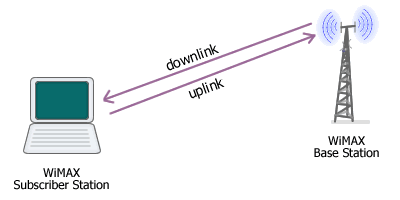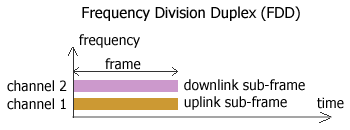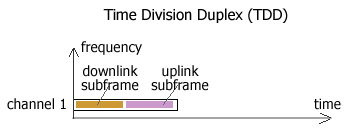Duplexing Scheme in WiMAX: TDD or FDD
Duplexing refers to the way downlink and uplink
data is arranged in a two-way wireless transmission. The downlink carries
information from a Base Station (BS) to Subscriber Stations (SSs).
Downlink is also known as forward link. The uplink carries
information from a SS to a BS. It is also called reverse link.
There are two types of duplexing scheme, i.e. FDD and TDD.

Picture. Downlink and Uplink
Downlink and uplink traffic in a 2-way communication.
FDD (Frequency Division Duplex) requires two distinct channels for
transmitting downlink sub-frame and uplink sub-frame
at the same time slot. FDD is suitable for
bi-directional voice service since it occupies a symmetric
downlink and uplink channel pair. FDD is commonly used in cellular
networks (2G and 3G). Meanwhile, WiMAX supports full-duplex FDD
and half-duplex FDD (HFDD or HD-FDD). The difference is in
full-duplex FDD a user device can transmit and receive
simultaneously, while in half-duplex FDD a user device can only
transmit or receive at any given moment.

Picture. Frequency Division Duplex (FDD) - full duplex mode
Downlink and uplink sub-frames are transmitted at the same time in two
adjacent channels.
FDD is inefficient for handling asymmetric data services since
data traffic may only occupy a small portion of a channel
bandwidth at any
given time. TDD (Time Division Duplex) is another duplexing scheme
that requires only
one channel for transmitting downlink and uplink sub-frames at
two distinct time slots. TDD therefore has higher spectral efficiency than FDD.
Moreover, using TDD downlink
to uplink (DL/UL) ratio can be
adjusted dynamically. TDD can flexibly handle both
symmetric and asymmetric broadband traffic.

Picture.
Time Division Duplex (TDD)
Downlink and uplink sub-frames are transmitted at different time
slots in one channel.
Most WiMAX implementations either on licensed or license-exempt bands will
most likely use TDD. The
reasons are TDD uses half of FDD spectrum hence saving the
bandwidth, TDD system is less complex and thus cheaper, and WiMAX
traffic will be dominated by asymmetric data. The first release of Fixed WiMAX
profiles support both TDD and FDD, while
Mobile WiMAX profiles only
include TDD.
|